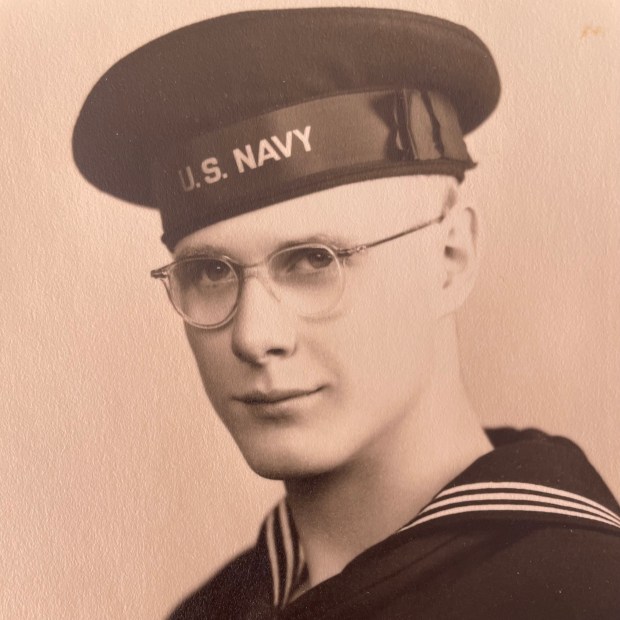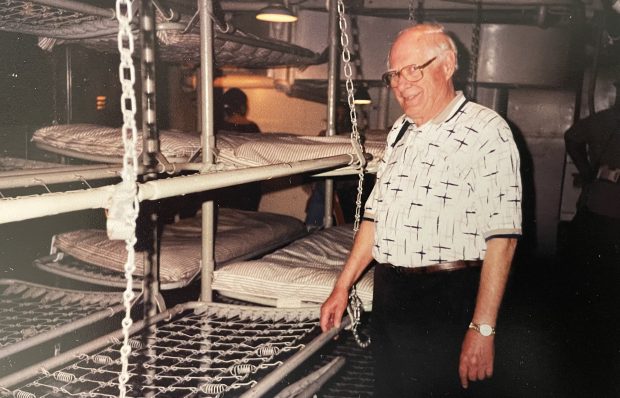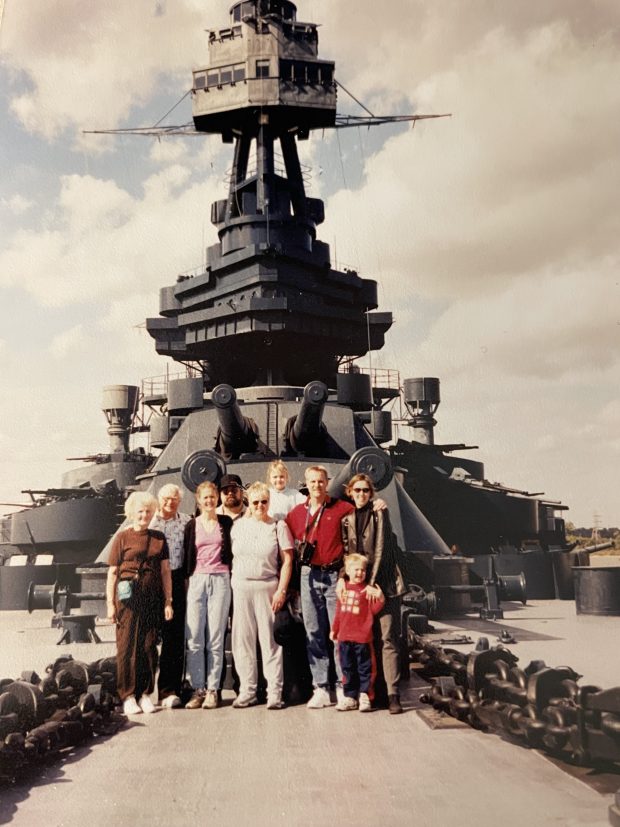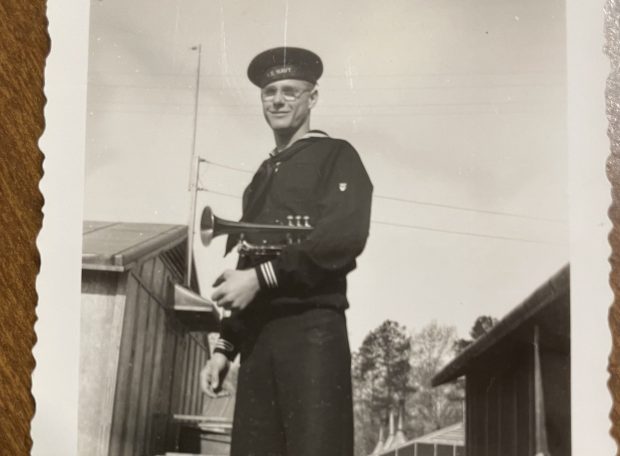Robert Larson had plenty of memories to offer as he prepares to celebrate his 100th birthday on Wednesday.
Some of the stories he shared when we sat down to visit at his home – at Covenant Living at the Holmstad in Batavia – were about a childhood during the Depression in Chicago with parents who emigrated from Sweden.
Larson also has plenty to say about his 35 years as a minister – in Michigan, Pennsylvania, Illinois and Rhode Island – mostly at smaller churches where he would often do double duty as pastor and choir director.
In addition to his deep Christian faith, music has always been one of this man’s great passions – a love that started with a used cornet his machinist dad bought for him for $8 from a merchant on Maxwell Street in Chicago.
Larson credits a music teacher who played French horn in the Chicago Women’s Symphony – along with his mother’s and sister’s housekeeping and babysitting money that paid for those lessons – for his musical abilities that so clearly impacted his life.
The retired reverend’s faith may have saved his soul, but it was his budding talents on this trumpet-like instrument that saved him from schoolyard bullies, who stopped teasing him about his thick glasses once they heard the sweet sounds he could produce in those solos at all-class assemblies.
“I developed more confidence,” he said with a smile. “It was beautiful to see.”
Music also played into Larson’s fate as the United States became drawn into World War II. Working as a machinist after graduating from high school, he tried to enlist in the U.S. Army Air Forces in November of 1942. Instead, he was steered to the Navy recruitment office next door where, outside on the sidewalk, a Naval bandmaster was searching for musicians to play on ships and shore stations.
After a quick audition the following day, Musician Second Class Robert Larson was eventually assigned to the USS Texas, an old but formidable battleship that became known for numerous technological firsts in gunnery, aviation and radar and for the many invasions she took part in during World War II.
In his early months on board, Larson crossed the Atlantic multiple times with the battleship that served as a flagship for large convoys to Northern Europe. But he truly became part of history on that May day in 1944 when the crew, while training for an unknown major operation, got an unexpected visit from Gen. Dwight D. Eisenhower.
After he and the Navy band played the ceremonial tune for dignitaries, the Supreme Allied Commander delivered what the crew eventually realized was a “pep talk” for the D-Day invasion that would soon take place.
“He was so, so close,” Larson recalled of that visit from the military legend and future president of the United States. “I could have almost reached out and touched him.”
The Texas was indeed one of the battleships that took part in the invasion of Normandy almost 80 years ago on June 6, 1944. Equipped “with the big guns,” noted Larson, her role as the invasion began was to support the landings of the Army Rangers at Pointe du Hoc and the landings on Omaha Beach.
That included taking out machine gun nests the Germans had planted on the high ground overlooking the beach so the Navy could clear the harbor of mines that would then allow safe landing of U.S. troops and supplies, he told me, adding that “when we fired all those guns at the same time, it was something … the ship would roll.”
As members of the band, he continued, “it was our job to be a musician when we were in port and a surface lookout when at sea. But when the ship was in battle, we became a medical assistant, doing whatever you had to do.”

That included helping save lives when 35 U.S. Army Rangers, who had been hit hard by German fire after becoming isolated at Pointe du Hoc, were brought on board for treatment, along with 27 prisoners of war.
One of Larson’s most compelling stories was when he assisted in the surgery of a Ranger who had been one of the last to be treated because he was “in a deep coma” from his serious injuries. As a doctor worked on removing shrapnel from the non-sedated man’s chest, Larson recalled the patient’s hand going directly to his wound.
“I was told to hold that arm” so the surgeon could work. “While I was doing that, the Ranger died,” said Larson, pausing briefly before adding, “I was hoping he was right with God.”
In addition to music, faith helped him get through the horrors of war.
Shipmates, Larson recalled, would see the New Testament he always carried in the uniform shirt pocket that was designed for cigarettes and “wanted to connect with me if they were searching for the Lord.”
Thus began a group that met regularly in the conning tower of the USS Texas for fellowship, support and prayer.
“We were bombarding, doing terrible things, but so was the enemy. I carry no guilt,” Larson insisted. “I felt our cause was just.”
On June 25, 1944, the USS Texas was sent to support efforts during the Battle of Cherbourg where, during one long engagement, he recalled, the ship took two direct hits by German shells: One did not explode and a second hit the bridge, wounding 11 and killing the helmsman.
After getting repairs to the damage to the ship in England, the battleship spent three mostly uneventful months helping with the invasion of Southern France. She went back to the United States for upgrades and modifications before heading to the Pacific, where the battleship took part in the February 1945 invasion of Iwo Jima, a fierce struggle that brought the crew closer to the enemy than ever before.
Larson distinctly recalls firing “the big guns against Japanese positions” and helping fight off Kamikaze attacks that “kept us from resting or sleeping.”
He also remembers witnessing what might be the most iconic moment of the war in the Pacific – watching from the deck as Marines raised the United States flag atop Mount Suribachi.
The ship, which was equipped with a staggering number of anti-aircraft guns, spent 50 days near Okinawa during the battle there. According to the Battleship Texas Foundation, not only did that “set a record for days at battle stations” this final major battle was “by far its hardest.”
One of the men in his prayer group was responsible for feeding those battle-weary sailors for so long, recalled Larson, who shook his head at the memory of this tireless cook he and his shipmates labeled “a hero.”
The USS Texas was in the Philippines awaiting an eventual invasion of Japan when word was received the atomic bomb had been dropped, thus ending the war. By that time the musician’s term of service on the Texas had expired and he was on his way back to the States, where he ended his three-year military career in Washington, D.C., with the U.S. Navy School of Music.

Larson considers his time on board the battleship as “my first year of seminary.”
After being discharged in January of 1946, he spent the next eight years studying theology. At age 37 and now a pastor, he met wife Edith and together they raised three children, including namesake Robert Larson, a North Carolina radiologist who will be among family and friends celebrating the Navy veteran’s remarkable birthday on Wednesday at Holmstad, where he lived in retirement with Edith until her death in 2012.
“We had the best dad,” said the younger Larson, describing how his father would throw a ball to him or shoot basketballs in the driveway for hours on end.
And yes, added the son, his father talked freely about his war experiences, which made the family’s 2002 trip to the USS Texas in Houston so special.
Because Larson had been on the crew of this battleship, the group of nine, including a couple of grandchildren, was given a private tour of what is now a museum owned by the state of Texas. It is currently under renovation in Galveston, where it will remain.

Larson took a photo in front of the conning tower. He pointed out where the mast was that he had to climb for lookout duty – four hours on, eight hours off, rotating with other band members.
He even showed family the bunk where he slept … or tried to.
Larson admits those events of long ago can come rushing back, powerfully, vividly, especially around Memorial Day when he can’t help but think about that young Ranger – “truly a hero” – who practically died in his arms.
“I relive those days, but they are mostly good,” he told me. “The human heart is deceitful; it protects you from the bad things you don’t want to remember.”
Besides, the old vet knows he’s had a wonderful life, filled with so many blessings and certainly influenced by his time at sea during a world at war.
“It all helped me come to a decision about my life’s work, to be a musician or a minister,” said Larson. “And I ended up encompassing them both.
“The Lord has been good to me.”
dcrosby@tribpub.com




